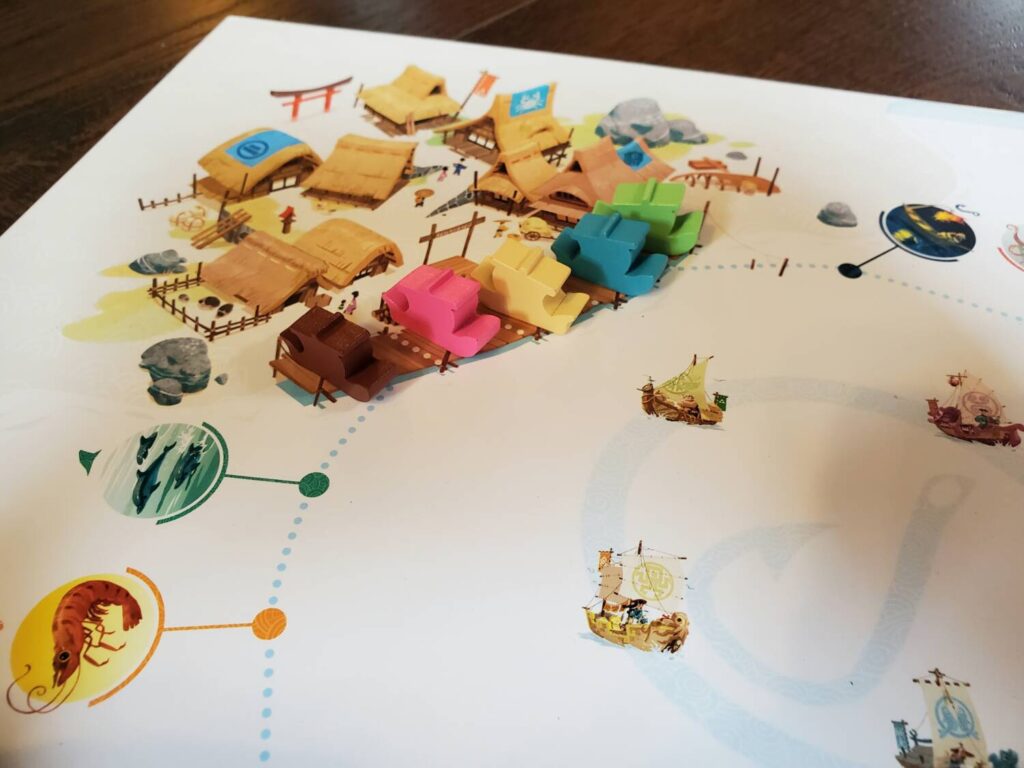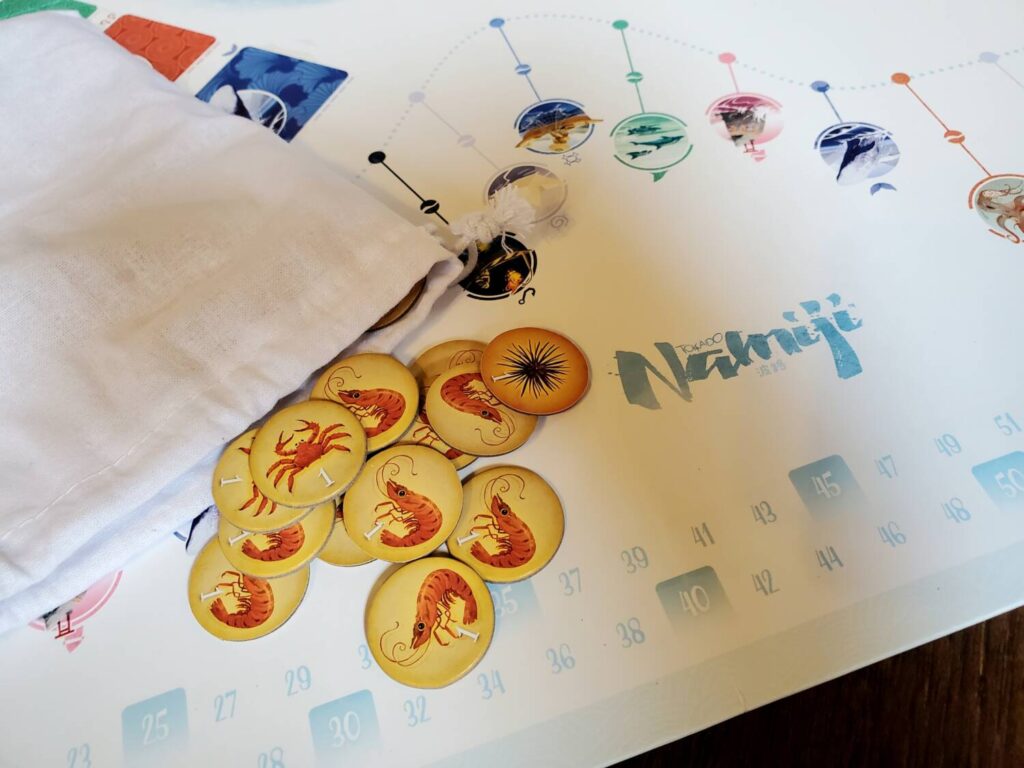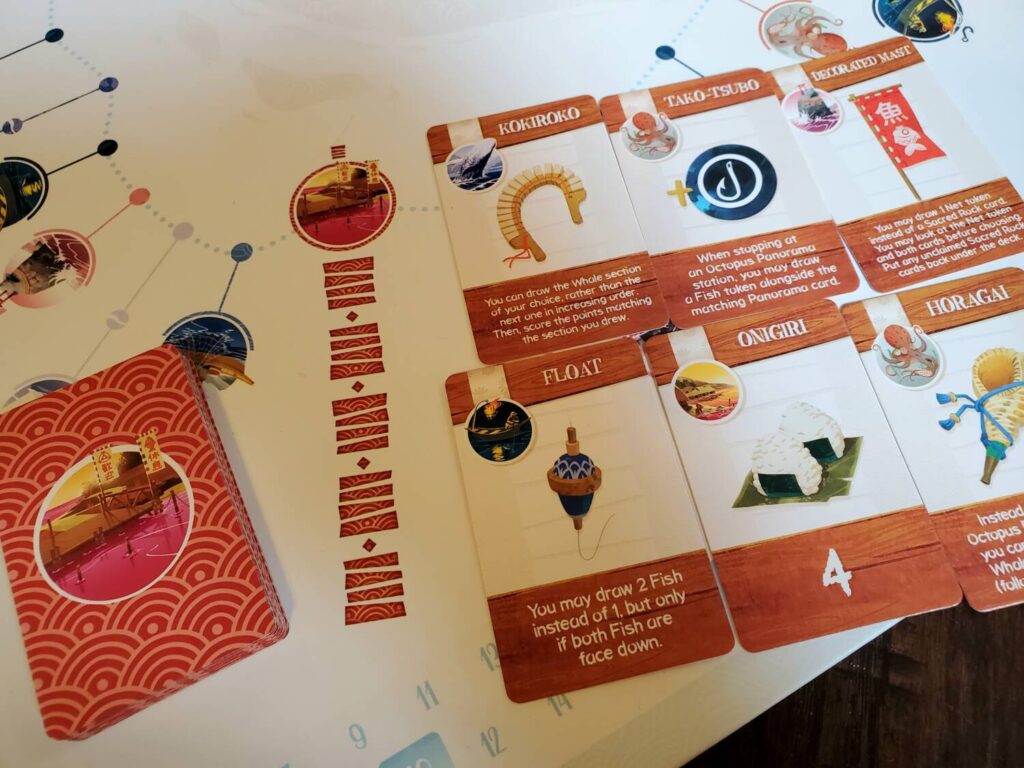Without a doubt, Namiji would have been the first Kickstarter I ever backed—had I been into that sort of thing at the time. Instead, months later, that honor fell to Marvel United, a far less frustrating venture in the end. I watched the anticipated fishing game from a distance as delay after pandemic-fed delay pushed the eventual release back years from the original projection. I can only hope those who persevered got a badge or a really nice sticker for their troubles.
But here I am, four years later, with a copy of Namiji on my table, the seafaring sequel to the chillest game in a white box, Tokaido. Our family has walked the Tokaido road countless times, often in both directions. We have expanded and deluxified our copy and guarded it with our lives. Well, except for that one piece that my sister’s dog mangled. Consequently, if anyone has a spare purple base ring for the Collector’s Edition minis laying around, drop me a comment and I’ll make you an offer.
When the first copies of Namiji delivered, I had a chance to play a friend’s deluxe version, complete with painted ships and 3D paper boats. I never really doubted that I’d enjoy it; but I hadn’t seen it again until now. It has all the same vibes as its predecessor, but I’m going to try my best to see it for what it is.
Hook
In Namiji, players travel in leap-frog fashion around a loop of spaces collecting sets of aquatic things. The player whose ship is at the rear moves forward as many spaces as they’d like to collect whatever suits their fancy. The only limitation is a series of three docks that divide the game’s timeline in four. The game is so loose that travel works in both directions. We just let the first player choose.

There are several sorts of spaces. Angling stations are for the collection of fish. Players’ boat boards contain a 4×3 grid for fish tokens. The aim is to collect rows and columns that contain either the same color or the same type of fish. Every stop leaves one additional token face-up, creating incentive or pushing players to the randomness of the sea. Net casting stations provide fish in matching pairs, but (almost) always at random.
Crustacean traps send players to a bag of tokens where they select up to five, stopping any time. If at any point two crabs surface, the whole lot is lost and tossed back into the bag.
The whirlpool station gives players a chance to send paper boats into the sea as an offering to the aquatic deities. Failure to shed these paper boats results in lost points at the end of the game.

Panorama stations gradually reveal three majestic creatures of the sea—the dolphin, the squid, and the whale. Each successive piece is worth an increasing number of points and the first to gaze upon each creature receives a bonus.
The Sacred Rock stations provide goals for the end of the game by selecting one of two cards from the deck. These goals give a gentle nudge toward some of the other stations.
The Docks introduce a break in the action. Players choose their spot on the dock. The first space chooses from a handful of cards a special ability or a point bonus that suits strategic hopes. Successive spots also choose a card until the player in the last position selects from only two. BUT, the last position is also the first player out, opening the door to glorious possibility on the path ahead. When players arrive at the starting dock again, the game ends.

Line
The Aquamarine mini-expansion adds modules to the Namiji experience. The upgraded Whirlpool adds bonuses to the shedding of paper boats. Rather than avoiding pain, the new pool bestows the slightest of pleasures.
The new Crustacean tokens add a dash of variety to the bag with special shrimpies, sea urchins, rocks, and shrimp/crab combos. New Dock and Sacred Rock cards expand possibilities, and wild rainbowfish add a splash of color to the player boards.
Less an expansion than a series of promotional extras, Aquamarine fits like a glove. The Whirlpool is questionably better, but the rest fit seamlessly into an already simple and streamlined system.
Sinker
There is absolutely nothing thrilling about Namiji. And I like it.
The only tension stems from the desire to remain dogmatically predictable. When I start the whale panorama, gosh darnit, I want to finish the whale panorama without interruption. When I am fishing for blue eels, I want my blue eels. The only trouble is, the other humans around me never seem to appreciate my intended rhythms and they are always getting in my way.
I like the fishing puzzle. Tokens begin in the upper left and must be placed orthogonally adjacent to previous tokens. Casting the net for a double sounds great, but the catch is often better suited for release because it doesn’t quite match the need. It’s a gamble, I say. The rainbowfish ease the struggle, but the struggle wasn’t exactly strenuous to begin with. Still, it keeps my attention.

My kiddos adore the crustaceans. They just love going to the bag. When the waters are cooperating, there are points in the bag, but it’s not as certain as all that.
The docks are well executed. There is a reason to be first, because some of the abilities are significant, and not every card matches every strategy. There is also a reason to be last, just to chase a particular station. But what I love the most is that there is often a reason to be second or third, too. Players might anticipate the needs of the leader and choose a position in the middle to maximize both card selection and order of departure. Of course, they might also meet with disappointment when humans do what humans do.
At no point does Namiji set the world aflame. I would argue a game like this doesn’t even try, nor does it have to.
OK, fine, I’ll compare it to Tokaido
Thus far I’ve tried to avoid saying just how similar the two games are. I wanted to give Namiji a chance to stand on its own two (sea) legs. But these siblings beg comparison.
In theory, Namiji is the better game. Antoine Bauza adjusted the few shortcomings of Tokaido right here in the base game box. Most notably, the docks. On land it took an expansion for the ruleset to officially make the intermittent stops interesting and somewhat equitable. Here on the sea, the docks are instantly the most engaging locales on the board.

Likewise, Namiji avoided inert spaces from the beginning. No hot springs with grab bag points to frustrate the anti-randomness crowd! Yes, the panoramas feel somewhat motionless, but isn’t that the point? And besides, there is a low-key race to finish the behemoths (and/or leviathans) to keep eyes alert to the board state.
To top it off, Namiji added a push-your-luck bag and a spatial puzzle? Come on, it sounds like a slam dunk.
And yet, I still enjoy the expanded Tokaido more. There’s just something about the hike that appeals to me. I can always adjust the rules at the Inn to better match those at the Dock, and the Inn brings the economic pinch for a touch of added sweat. I enjoy the characters and their monetary considerations. There’s something very personal about fighting for farm spaces, leaving coins in the temple, and spending hard-earned pay on souvenirs.
In sum, the coins provide the narrative thread that makes Tokaido the clear winner for me. The private consideration of money holds the hike together in a way that distinguishes its personality. Will I choose a money character? Will I chase money? If so, how? Will I spend money? Will I donate money? And yet, despite the centrality of the coins, the game doesn’t feel like a pure cash exchange. Somehow those delightful metal bits manage to slip into the cloud of the relaxed atmosphere, guiding the play without dominating the overall ethos.
I plan to hang on to both. As I said, I still jumped at the chance for a review copy even though I had already seen the best the game has to offer. Both Tokaido and Namiji claim a pace that I find satisfying for a family game night. We can relax and chat. We can miss a point or two on the scoreboard because every earned point can be counted and recounted at any time. We can get overly interested in small things and laugh at our losses. I like that in a game sometimes.
Overall, I say Namiji is a winner in the same way Tokaido is a winner. If you want to explore that Japanese setting from a different vantage point without too jarring a change, you’ll find friendly waters in Namiji.












Sold!
Tokaido is a favorite — and this sounds like a worthy successor. I will be adding this to my wishlist!
Thanks for a wonderful review.